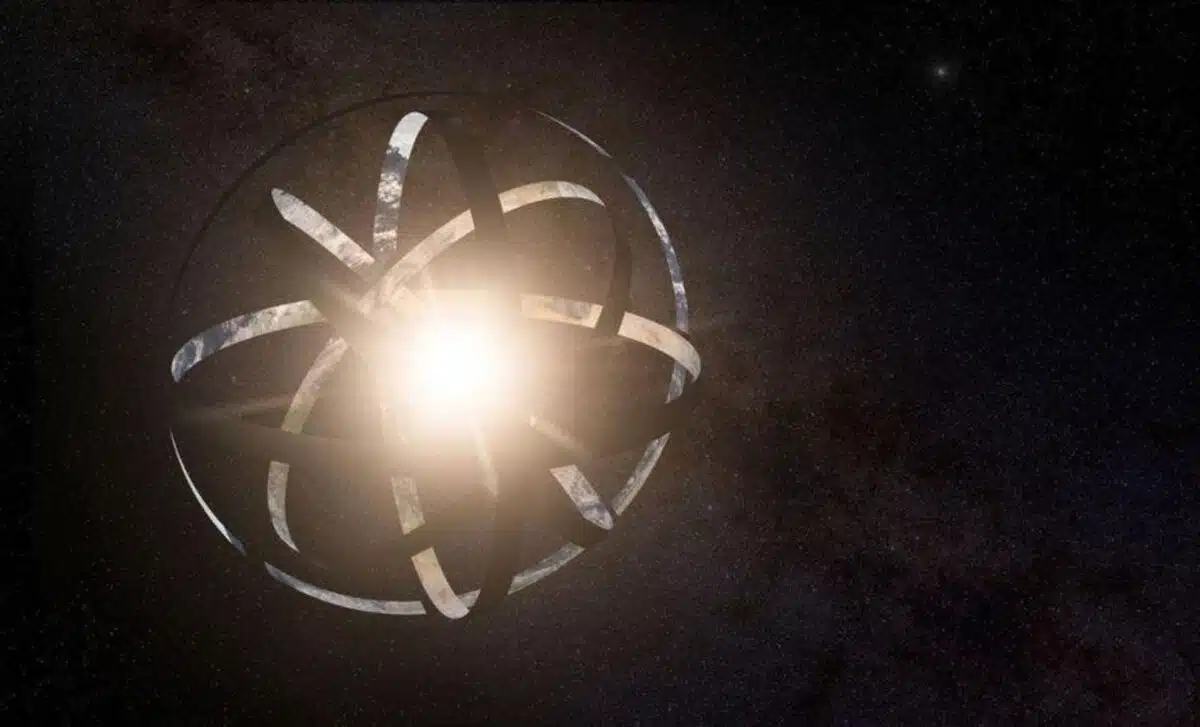
By Lydia Amazouz Published on July 6, 2024 12:09
Collected at: https://dailygalaxy.com/2024/07/dyson-spheres-key-universes-missing-matter/
Recent studies have sparked renewed interest in the concept of Dyson spheres, theoretical megastructures that could potentially harness the energy of entire stars.
This intriguing idea has led some scientists to speculate whether such structures could account for the universe’s missing mass. However, despite the excitement, many experts remain skeptical about the existence of Dyson spheres and their role in explaining astronomical phenomena.
The Concept of Dyson Spheres
The idea of Dyson spheres was first proposed by physicist Freeman Dyson in 1960, inspired by the science fiction novel “Star Maker” by Olaf Stapledon. Dyson suggested that an advanced extraterrestrial civilization might construct enormous structures around their stars to capture solar energy.
These structures, while blocking visible light from the star, would emit infrared radiation, potentially making them detectable by astronomers. “It could just be normal old astrophysics at play,” said astrophysicist and science writer Dr. Ethan Siegel, highlighting the need for extraordinary evidence to support the existence of such megastructures.
The concept gained significant attention with the discovery of the mysterious star KIC 8462852, also known as Boyajian’s star, which exhibited irregular and significant dips in brightness. Some speculated that these could be caused by an incomplete Dyson sphere, though this remains unconfirmed.
Missing Mass in the Universe
Astronomers have long been puzzled by the missing mass in the universe. There are two types of missing mass: dark matter, which is necessary to explain the gravitational behavior of galaxies, and regular matter, primarily composed of hydrogen and helium, which appears to be in short supply based on current observations.
While dark matter is believed to consist of exotic particles, the missing regular matter remains a mystery. Some have proposed that enormous filaments of gas stretching between galaxies might account for it.
Could Dyson Spheres Account for the Missing Mass?
Despite the fascinating nature of Dyson spheres, they are unlikely to account for the missing mass in the universe. Complete Dyson spheres, which would entirely encircle a star, are deemed impractical due to the immense amount of material required and the gravitational instability such structures would face.
Even if constructed, these spheres would likely be very thin and unstable, making them implausible. More plausible are Dyson swarms or rings, networks of solar-energy-collecting satellites orbiting a star. These structures would only capture a small fraction of a star’s light, making them easier to construct but far less likely to account for the missing mass. Additionally, if such swarms were common, their infrared radiation should be detectable by telescopes like the James Webb Space Telescope (JWST). However, no such evidence has been found to suggest they are widespread.
Recent Observations and Skepticism
A recent study published in the Monthly Notices of the Royal Astronomical Society reported the discovery of seven stars with unusual infrared signatures, potentially indicative of Dyson spheres. These stars, located within 1,000 light years of Earth, exhibit heat signatures that cannot yet be fully explained.
However, many experts remain skeptical. Dr. Janna Levin, a theoretical cosmologist at Barnard College, suggested that these signatures could be due to natural astrophysical phenomena such as planetary collisions or young stars with surrounding material. “Heat signatures are so generic in nature that it’s far from a smoking gun and there are many possible natural explanations,” Levin told Salon.
Astrophysicist Dr. Erik Zackrisson, one of the study’s co-authors, echoed this skepticism, noting that while these stars are the best candidates for Dyson spheres so far, other explanations such as dust from cosmic events or background sources are also plausible. “They are the best Dyson sphere candidates we’ve come across so far, but this does not mean that they are Dyson spheres, or even that Dyson spheres represent the most likely explanation for the phenomenon we’re seeing,” Zackrisson said.
The Scientific Value of the Search
Despite the doubts, the search for Dyson spheres holds significant scientific value. It encourages the exploration of unconventional ideas and fosters interdisciplinary research combining astrophysics, history, and other fields. The potential discovery of alien megastructures would be a groundbreaking achievement, transforming our understanding of the universe and the existence of advanced extraterrestrial civilizations.
“What could be more exciting and existentially terrifying than the discovery of alien life?” Levin pondered, emphasizing the importance of keeping an open mind while maintaining scientific rigor. Dr. Siegel added, “It’s important to keep an open mind, and it’s easy to understand why the most wild possibilities excite us. But without stronger evidence, this is just another example of people getting hyped up over what’s almost certainly going to be a big nothing-burger.”
In conclusion, while Dyson spheres remain a captivating theoretical concept, their existence as a solution to the universe’s missing mass is highly unlikely. The ongoing search for these megastructures, however, continues to inspire scientific inquiry and the pursuit of understanding the cosmos.

Leave a Reply